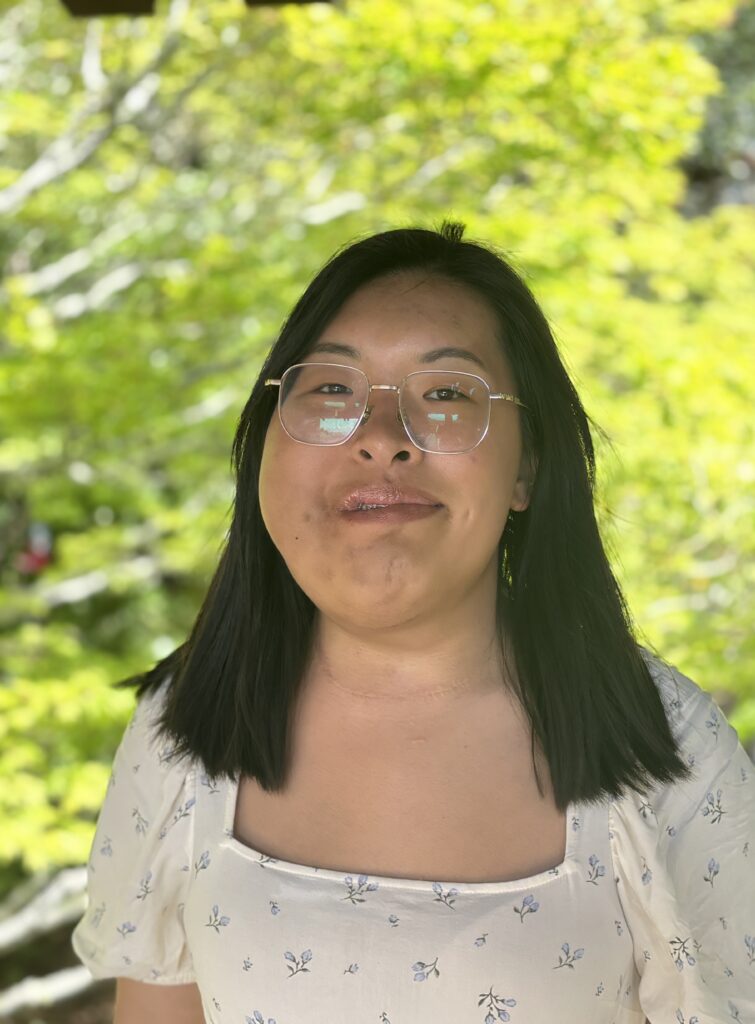Undergraduate Profile: Sabrina Anh Nguyen
Sabrina Anh Nguyen is a 4th year Classical Studies, History, and Literature Major who was awarded a 2024-2025 THI Undergraduate Research Fellowship. Nguyen’s research examines Roman marriages between enslaved women and their male enslavers as a way to escape slavery. In addition to her THI Research Fellowship, Nguyen was an Intra-American Slave Trade Database Research Intern in Summer 2024 and she has participated in the Okinawa Memories Initiative, both projects housed at THI. We caught up with Nguyen to hear more about her research at UCSC.
Hi Sabrina! We’re excited to hear about the project you are working on for your THI Undergraduate Research Fellowship. Could you talk to us about your research and what got you interested in the subject?

Thank you for having me! My research focuses on marriages between enslaved women and their male enslavers, formed specifically for the purpose of manumission (the legal granting of free status). Manumission through marriage was particularly encouraged during the first century CE, when the Roman Emperor Augustus passed a series of legal and moral reforms, which incentivised reproduction and marriage. In addition, Augustus restricted the age at which manumission could occur, and established marriage as an exception that allowed manumission prior to the age of 30. My project analyses the ways in which marriage to one’s own enslaver limited the freedom granted to freedwomen both legally and through other means of coercion indicated through funerary inscriptions and Roman legal texts. My interest in this topic came out of a broader interest in the role of women and marriage in Roman society and literature, and it wasn’t until I read Freedom in Marriage? Manumission for Marriage in the Roman World by Dr. Katharine Huemoeller, that I became aware of the intersection between Roman slavery, freedom, and marriage.
That is a fascinating subject! It sounds like much of your work relates to translating Roman legal texts. For those without translation experience, can you walk us through your process?
Of course! A large portion of the research I conducted for this project, involved translating Roman funerary inscriptions, which makes up a majority of sources about freedwomen. Most Latin inscriptions can be accessed through the Corpus Inscriptionum Latinarum (CIL), which is available online through a searchable database. The CIL contains thousands of Latin inscriptions from all areas of the Roman Empire, so in order to narrow the search, I started by looking up specific search terms. For example, the Latin words for spouse (coniunx) and patron (patronus) are necessary terms in order to establish that the relationship described in the inscription was between a freedwoman and her enslaver. From the search, I combed through and read inscriptions that contained some form of the search word and pulled examples that were relevant. Latin inscriptions without the aid of the CIL are difficult to read because inscriptions are written following specific abbreviated conventions, in order to save space and cost. As a result, Roman epitaphs tend to follow specific conventions and patterns, and many of the inscriptions that were relevant to the project, contained very little information about either spouse, beyond establishing their marital and patronal connection.

There are, however, inscriptions that provide other forms of information such as curses or references to the status of children, which contain information about the effects and nature of these marriages. The scarcity of epigraphical sources that contain information about freedwomen married to their spouses makes it difficult to speak about these women in broader terms. Legal texts provide a more generalized view of freedwomen and manumission through marriage. The main sources for Roman law in the first century CE are The Digest and Gaius’ Institutes, which are compilations of Roman law and discussions of legal jurists. Translating these texts mostly involved reading relevant sections indicated by scholars and indices.
What were some of the surprises or interesting things you discovered during your research?
When I initially started this project, one of the first sources I read about was a curse created by a man named Marcus Iunius Euphrosynus to his wife, Acte, which was placed on the back of a monument dedicated to their child, a young girl named Iunia Procula. The front side of the monument contains an inscription commemorating the death of Procula who passed away at the age of eight, and which memorializes the grief of her parents. The front inscription doesn’t present a lot of information about the relationship between Acte and Euphrosynus, but some time after the monument was made, a curse was added to the back and the name of Procula’s mother was removed from the original dedication. The contents of the curse reveal that Acte ran away with her lover, taking with her two other enslaved children. This particular dedicatory monument has been well-studied by scholars, and there are a number of interpretations put forth about the nature of the relationship between Procula’s parents.

What I found particularly interesting about this source, is that it represents the often problematic nature of inscriptional evidence. Funerary inscriptions are intended to be idealized representations of both the deceased and dedicator because they are public monuments which would have been seen by family, friends, and strangers. As a result, funerary inscriptions don’t necessarily reflect lived realities nor changes in the relationship between two individuals. The initial inscription does not mention the fact that Acte was formerly enslaved by Euphrosynus, nor that there was any animosity between them. The additional curse, reveals how their relationship was perhaps a facade or changed after the passing of their daughter. Without the happenstance of this curse being both created and preserved, there would be no memory of Acte, nor the ways in which she was exploited and controlled by her husband in exchange for her freedom. Although the curse was written from the perspective of Euphrosynus, it’s possible to also read Acte’s experience of their marriage which was so unbearable she risked running away. Acte’s experience is not unique, but the curse is one of the most in depth examples which provides detail about a marriage formed through manumission.
Why has it been important for you to pursue an independent research project during your time at UCSC? How has support from THI made that possible? And what are some of the ways you plan to share your research and/or continue this work in the future?
Independent research has allowed me to explore new facets of Roman literature and history. While I had studied marriage and slavery in the Roman empire in the past, the intersection of those institutions was not something that I had been able to research and study prior to this project. The research I conducted gave me the opportunity to work with new sources and to learn how to analyze and interpret Roman inscriptions and funerary monuments. The undergraduate research fellowship provided me with the support to complete this research, and opportunities for my research to exist outside of my thesis, most notably in the form of a poster and a chance to present my work to the public. In the future, I hope to keep pursuing this topic and to further develop my understanding of Roman manumission and marriage, and to continue to look for evidence which speaks to the experiences of freed and enslaved women.
Along with your THI Research Fellowship, you were also an Intra-American Slave Trade Database Summer Research Intern. From partnering with students from HBCUs, to traveling to do hands-on research, it must have been an important experience. Would you mind sharing some of the things you learned from this opportunity?
The internship was certainly a very sobering and impactful experience for me. Most of the documents that we worked with both at UCSC and in North Carolina, were government port records which recorded the forced movement of enslaved individuals across state lines. Each document contained a list of every enslaved individual that was on a particular voyage and documents produced after 1808 included personal and demographic information. These documents articulate the systemic, institutional and pervasive dehumanization of enslaved people. Many of the documents that I read were records from Savannah, GA and Roanoke, NC. The overt normalcy that these records displayed was striking. Over several weeks, I encountered and began to recognize the same few captains, ship names, and government workers who all made a livelihood and profit by forcibly moving enslaved people. In the records themselves, the normalization of the unfathomable pain and suffering was noticeable in the illegibility and rushed nature of the handwriting and the constant use of shorthand and abbreviations. One of the most impactful aspects of the records were the lists of names, which varied from two to a hundred enslaved individuals per voyage. Encountering these names and the demographic data which accompanied them, made me reflect on the individuality of those on these voyages and made their experiences more tangible.
We heard you also volunteer with the Okinawa Memories Initiative (OMI). Could you describe your role with OMI and how that experience has influenced your time at UCSC?
I’m currently a volunteer with OMI, and have worked primarily with the project to scan photos from the Yamashiro family collection. I think that OMI has had a really positive impact on my college experience. Throughout my time working on the project, I have learned a lot about the Okinawan diaspora and the importance of public history for both the preservation of culture, but also as a resource for members of the community to connect with and learn more about Okinawa and its diasporic history. OMI has also been a really wonderful community, and through the project, I have been able to meet other students from a variety of educational backgrounds who are interested in some aspect of oral history, cultural preservation, archival work, and exploring the boundaries of what the academic of pursuit of history can entail.
Thank you so much! To wrap up, please share a place everyone should visit in Santa Cruz at least once.
I am a big fan of studying and hanging out at 11th hour’s downtown location. I think its a great place to sit, chat and to soak up some sun!
Banner Image: Altar in honor of Junia Procula. Front.
